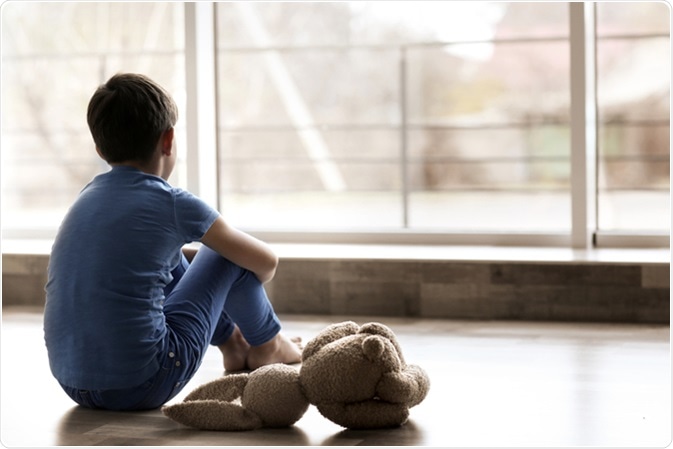There are certain phases during childhood in which social anxiety is experienced by a majority of children. This phase is not permanent and will often pass as the child gets older. However, some children are unable to overcome this form of anxiety, which may turn into a source of more serious anxiety disorders as the child gets older.
Classifying social anxiety
Social anxiety disorder is usually divided into two main categories. The first type of social anxiety disorder focuses on social performance, which includes abnormalities such as talking in the classroom and throwing tantrums. The other type of social anxiety disorder is more focused on the individual's social interactions, such as when the child is afraid of making new friendships or has a fear of going to school.
The average age of onset of social anxiety disorder in children is 13 years; however, this phobia may begin to develop around the ages of 3 or 4. Parents, therefore, need to prioritize early treatment of the condition before it worsens.

Image Credit: Africa Studio / Shutterstock
Symptoms of social anxiety disorder in children
Children with social anxiety disorder show some signs and symptoms that are not seen in normal children. These may be physical, emotional, or behavioral, and might include:
- Excessive crying
- Excessive reliance on parents or caregivers
- Throwing tantrums very frequently
- Avoidance of interactions with friends and adults
- Having problems with meeting other children or mingling with groups
- Fear of going to school and taking part in classroom activities such as responding to teachers, as well as avoiding participating in school performances and social events
- Showing excessive shyness
- Having very few friends
- Frequent avoidance of social situations where they might draw attention to themselves or have to be in the front
Causes
There are several different causes that may lead to the development of a social anxiety disorder in a child. Situations where the child fails to perform properly and experiences embarrassment are often associated with an increased chance of social anxiety. Familial social anxiety may also arise when the parents have genetic predispositions to this condition.
Social Anxiety in Children and Teens
Treatment approaches
Patients with childhood social anxiety respond well to psychological therapy as compared to when only self-help treatment methods are utilized. The main aim of treatment is to change the child’s behavior from provoking the disorder.
The two common techniques of treatment of social anxiety in children include psychotherapy and pharmaceutical therapy.
Psychological therapy
Psychological treatment may be summarized by the two chief modes of therapy, namely cognitive-behavioral therapy (CBT) and exposure therapy.
CBT
CBT is a very effective treatment option for children with anxiety disorders. CBT works to improve the child’s attitude by enabling better coping with the social environment during anxiety-producing situations. This therapy also helps to teach children to overcome their fear and change the structure of their anxious thoughts.
Exposure therapy
Exposure therapy involves a therapist who gradually exposes the child to situations that are associated with their anxiety. This slowly reduces the intensity of the fear response in the child’s mind. Exposure therapy is an important method that is associated with considerable success in reducing the severity of social anxiety disorder in children.
Pharmaceutical treatment
Pharmaceutical treatment for social anxiety disorders inc children involves the use of medications to alleviate the symptoms of anxiety when the child confronts the anxiety-inducing situation.
Behavioral therapy is helpful and effective in a subcategory of children. However, drugs such as selective serotonin reuptake inhibitors (SSRIs) have been found to be effective in managing several symptoms of social anxiety disorder. Beta-blockers are another type of medication that has been found to help children in confronting their fear of social situations while also reducing symptoms such as sweating and palpitation.
Involvement of parents and caregivers
Children usually trust their parents, as the connection or bond between the child and their parents is very strong. Therefore, it is very important that parents actively participate and have a leading role in guiding their children through anxious situations or dealing with their anxiety disorder.
To this end, some tips are available to help parents and caregivers in facilitating the successful management of this disorder at home, such as:
- Paying more attention to the feelings of the child
- Not punishing the child for mistakes
- Not punishing the child for getting low grades or for lack of progress
- Adjusting one’s expectations of the child during challenging phases of their life
- Participating in and enjoying the child’s activities
- Recognizing and praising even small accomplishments
- Remaining calm when the child becomes anxious about a situation or event
- Making a normal and simple routine for the child’s daily activities, which is flexible enough to be altered in accordance with the child’s progress
To some extent, social anxiety disorders may add stress to family life. Therefore, it will be helpful for parents to build a support network with relatives and friends, or with their peers in similar situations.
References
Further Reading